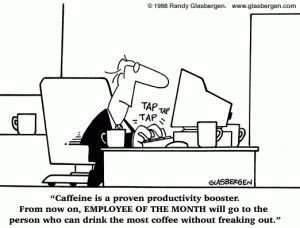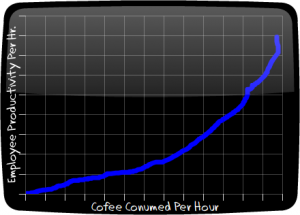Recurring dream
20 de março, 20094 considerações sobre liderança
24 de março, 2009Texto muito interessante da infoQ sobre como ter times super produtivos:
http://www.infoq.com/news/2009/03/hyper-productive-team
Aliás, esse texto é um resumo de 4 artigos sobre Group Coherence de Joanna Zweig e Cesar Idrovo publicados Agile Journal baseados em uma pesquisa feita por eles:
- Group Coherence for Project Teams – A Search for Hyper-Productivity
- Group Coherence for Project Teams – Common Purpose
- Group Coherence for Project Teams – Collaborative Interaction e
- Group Coherence for Project Teams – Group Creativity.
Ao contrário do que reza a lenda, não basta só ter certeza que a máquina de café esteja funcionado…


Vou fazer como a infoQ e vou colocar abaixo um resumo do resumo! 🙂
Primeiro a motivação:
“Group characteristics and group dynamics are invisible to most of us. We are not trained to detect them, let alone manage them. Our work is influenced by much more than what we see. This can make project success (and failure) sometimes appear to be random.”
Em seguida, uma definição:
“Group Coherence is the shared state reached by a group of people that allows them to perform one or more tasks in perfect rhythm and harmony with great energy to overcome obstacles. This simplistic interpretation is a starting point for discussion and we acknowledge that it doesn’t begin to do justice to all the interdisciplinary components of Group Coherence that include behavioral, psychological, spiritual and sociological.”
E depois vêm as constatações (os destaques são meus):
“In our continuing search for Hyper-Productivity, we have observed that a strong and highly adaptable shared sense of Common Purpose can increase the group’s ability to execute on the project vision or enterprise strategy.”
“The hyper-productive teams we have observed apply high rates of practical collaboration. We believe that fostering Collaborative Interaction leads to increases in productivity, yet performance is recognized at the individual rather than team level. In environments where collaboration is required, managers should avoid assigning project work and accountability to individuals.”
“Creative achievement is typically associated with individual effort. Think of Newton, Edison, or Leonardo Da Vinci. Until not very long ago, creativity and design were the focus of a few, while the work of the masses was broken down into repeatable steps. Creativity was perceived to undermine the result of mass-production.
Today, the work depends on the design and creative skills of the knowledge workers that perform it. In this post, we explore the different ways in which Agile methods foster individual creativity and allow for something far less commonly acknowledged: group creativity. We discuss four attenuators and five amplifiers of group creative activity.”
Abaixo estão os 4 atenuadores:
- Specialization “blinders”
- Micromanagement
- Chaos avoidance
- Pre-determined truth
E os 5 amplificadores:
- Create Opportunities for Practice
- Reward Teams
- Tolerate Chaos
- Socratic questioning
- Shared Leadership
E a conclusão:
“In hyper-productive teams there are high levels of group creativity despite functional specialization. These are groups that are willing and allowed to experiment. Group Coherence can help understand the ingredients that can be observed when this happens. In the research these include Trust and Respect, Bonding, Loosening Boundaries, Shared Leadership, Agreement on a Shared Goal and Tolerance for Chaos. These formed the basis for this post. They cannot guarantee an earlier or more dynamic occurrence of group creativity, but their absence can prevent or delay its emergence.
They are also all available to Agile teams.”
